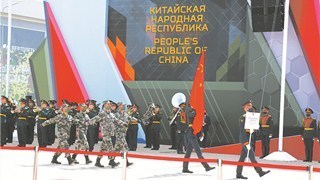By Ge Hongliang
After Biden took office in January this year, he has repeatedly expressed how much importance he attaches to the Southeast Asian region and created the new position of senior official for Asia policy. An observer of American think tank once claimed that although Southeast Asia is leaning toward China, it's still possible for the US to take it back. It seems the Biden administration is determined to win over the region as a highland to execute its regional strategy.
Southeast Asia expressed its goodwill to Biden too, hoping he wouldn’t be as capricious as his predecessor and would pay equal attention to the region as the other Democratic president Obama and spend time participating in multilateral economic and diplomatic activities. Now it’s been six months since Biden was in office, and America has begun to take steps of “returning” to Southeast Asia, but the region is getting more and more disappointed with its goodwill vanishing.
It's true that Southeast Asia is an important region in Biden’s foreign strategy of re-establishing America’s global leadership by re-joining multilateral cooperation and re-shaping the international order, but it’s not the most important.
In sharp contrast to the goodwill expectation of Southeast Asian countries, the Biden administration seems too casual and indifferent to their “return” to the region. First, Washington expressed its interests in and support for the ASEAN-led mechanism. On March 17, the ASEAN-US Joint Cooperation Committee (JCC) held its 12th meeting online, at which the US expressed its willingness to take an active part in and promote regional peace, stability and prosperity through the ASEAN-led regional mechanism, and to continue supporting the construction of an ASEAN community. The two sides also discussed implementing the ASEAN-US Plan of Action (2021-2025).
However, the American host at the 12th JCC meeting was Melissa Brown, Chargé d’Affaires at the U.S. Mission to ASEAN, and the White House didn’t seem to be in a hurry to fill the position of US ambassador to ASEAN, which Trump had left empty for four years. This posed a sharp contrast to the lip service that the America pays to the region.
Second, the Biden administration hoped to demonstrate its attention to Southeast Asia through visits and meetings between senior officials. It planned to hold the first high-level meeting with ASEAN countries, via video link, on May 25, at which the US Secretary of State Blinken and ASEAN foreign ministers were to discuss COVID-19, the US-ASEAN relationship, and regional and international issues.
But Blinken flew to the Middle East for a string of visits on May 24 and, on the day of the meeting, kept the foreign ministers of 10 ASEAN countries waiting for nearly an hour as he was still on the plane. In the end, the video conference was called off due to “technical problems with communication and connection”. A Malaysian analyst commented that technical fault during the meeting undoubtedly reinforced the perception among Southeast Asian countries that they were being neglected by the US.
Washington is so indifferent to ASEAN because the strategic goal of its “return” to the region is not intensifying cooperation with regional countries, much less respecting and endorsing ASEAN’s position in the regional multilateral framework. Two points in Biden administration’s current foreign strategy have taken observers by surprise. For one, it has fully inherited the “Indo-Pacific Strategy” of Trump’s term and further materialized it; for another, it has continued Trump’s stance of strategic competition with China.
Southeast Asia is not of paramount importance in America’s foreign strategy. It is important only because it serves as a pivot for the US to promote the quadrilateral strategic cooperation with Japan, India and Australia in the Indo-Pacific and because it is in a way regarded as the forefront in America’s geopolitical competition with China.
Therefore, the US was only paying lip service when it pledged to respect and endorse ASEAN’s leading position, while its true and only purpose was to push its “Indo-Pacific Strategy”, coerce Southeast Asian countries to pick a side, maintain America’s strategic lead over regional countries, and restore and maintain its regional leadership.
When the US Deputy Secretary of State Wendy Sherman visited Thailand and said she wanted to make sure Thailand had a balanced relation, she already expressed America’s dissatisfaction with and criticism of the country and other countries in the region for strengthening cooperation with China. Obviously, apart from the keener awareness of neglect, Southeast Asia will continue to face enormous strategic pressure from the US, which will be anything but pleasing.
(The author is vice president of the College of ASEAN Studies, Guangxi University for Nationalities)
Editor's note: This article is originally published on huanqiu.com, and is translated from Chinese into English and edited by the China Military Online. The information, ideas or opinions appearing in this article do not necessarily reflect the views of eng.chinamil.com.cn.











